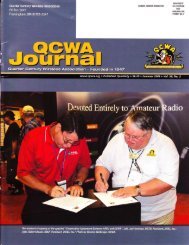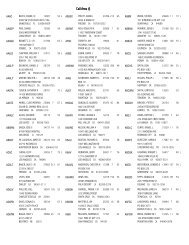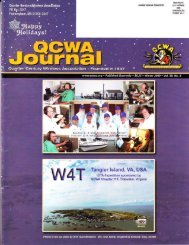Create successful ePaper yourself
Turn your PDF publications into a flip-book with our unique Google optimized e-Paper software.
QST articles outline a logicalapproach for you to foliow when designing<br />
or improving an exrsting system, The QST articles also give informatron<br />
on the required length of ground stakes and many other dimenstons not<br />
covered in this article. The problem of designing a safe system is similar<br />
to plugging holes in a leaking boai: lf you plug all of the holes except<br />
one, the boat sinks.<br />
After reading the 0ST articles, you should then look at some profes-<br />
sional resources. One good source of information can be found at the<br />
Polyphaser TCA Hotlinks in this article,<br />
The Problem Defined Through Examples<br />
An Ungrounded System Example<br />
A very simple poftable system is shown in Figure 1 . This is a typical<br />
system that you might take out camping. The small transceiver is bat-<br />
tery powered and is connected directly to a good dipole that is RF iso-<br />
lated by the use of a Balun, There is no connection to ground in this<br />
example, Since a Balun is used there will be very little RF current on the<br />
outside of the transceive; battery or coaxial cable. All of the RF radiat-<br />
ing current is confined to the dipole Hence, the RF pedormance is<br />
excellent and the ground is not used for any connections.<br />
However, there is a serious problem with the system. lf lightning<br />
strikes the antenna, it will find its way to ground and in this case the<br />
Radio Operator provides the conductron path. Also note that if lightning<br />
strikes the ground near the operating site Ground Spreading Current<br />
flows out in all directions<br />
A Grounded System Example<br />
The same portable system is shown in Figure 2 where a grounding<br />
stake has been added to the system. The ground stake is connected<br />
between the radio chassis and physicalground. Since the RF system is<br />
welldesigned, the safety grounding stake does not intedere with the<br />
performance of the radio This simple grounding system does not pro-<br />
vide much if any protection to the radio but there is a path to ground<br />
that will give some protection to the operator,<br />
Your Basic Needs<br />
The two simplified examples above show us that:<br />
. A g00d RF system can be designed that does not depend on a<br />
physical ground, However, a physical ground can be an integral paft of<br />
ihe antenna, An example of this is the vertical antenna mounted directly<br />
on ground with the aid of ground radials<br />
o A safety ground must be used since lightning will always find iis<br />
way to ground except for cloud-to-cloud strikes that do not reach us,<br />
. lf a Balun 0r some other RF isolator is not used,there can be large<br />
interactions between the RF system and the Safety ground system,ln<br />
the above examples, the grounding stake can make the antenna per-<br />
formance very poor if a Balun is not used.<br />
Safety Grounding<br />
lntroduction<br />
Lightning can strike power lines and enter into the house wiring as<br />
many of know from experience. Your house is grounded at the terminal<br />
box where most (not all) of the unwanted current will flow into the<br />
ground, Lightning can also strike the antenna/tower and enter into the<br />
house via coaxial cabling. Also lightning can strike near-by. This pro-<br />
duces large ground currents that can couple to the coaxial cables that<br />
feed the antenna sysiem. Hence, we have to attend to three dangers:<br />
Figure 1<br />
Ungrounded A,ntenna System<br />
Physical Ground<br />
Figure 1. Block diagram of a simple ungrounded antenna system.<br />
Notice that the radio operator is not protected. RF isolation is provided<br />
by the Balun.<br />
power line strikes, antenna/tower strikes and near-by ground strikes.<br />
After you have assembled an isolated antenna that does not produce<br />
unwanted RF currenis on the outside of coaxial cables and in the<br />
house, ii is now possible to design a good safety ground for your radio<br />
station.<br />
The following discussion starts at the tower or antenna end of the<br />
system and works its way back to the transmitter/receiver to a Single<br />
Point Ground Panel, Here we are assuming that lightning strikes at the<br />
antenna/tower,<br />
The Antenna/Tower Problem<br />
The best way to prevent unwanted coaxial currents fron reaching your<br />
equipment is to keep the current from entering the house by divefting it<br />
into the ground.<br />
During a strike, the tower and coaxial cables on the tower will share the<br />
current. This means that coaxial lines should be grounded at the top<br />
and bottom of the tower t0 prevent current from continuing towards<br />
your house on the cables,<br />
A block diagram of the recommended system is shown in Figure 3.<br />
Here, the antenna RF currents are isolated from the cables with a Balun<br />
connected as close as possible to the antenna, The coaxial cable ai the<br />
top of the tower, just below the Balun, is grounded with the aid of a<br />
Bulkhead Feedthru connector that is connected directly to the tower<br />
with a metallic mounting flange. Note that the outside if the Bulkhead<br />
connector is grounded, not the center conductor.<br />
The cable is also grounded at the bottom of the tower and the tower<br />
is grounded via a series of ground radials as described in TCA Hotlink,<br />
5 Most of the unwanted current from the lightning strike will now be<br />
diverted into ground. The system is not perfect due to the inductance<br />
and resistance of the connections and the finite resistance of the<br />
ground radials. Some of the current will stiil travel towards the house.<br />
A nearby strike will produce ground currents that can be coupled to<br />
!l[ ) QCWA Journa . Winter 2Oa7 . w\\w,qcwa org



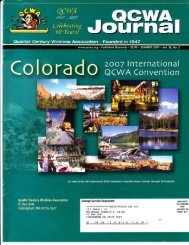
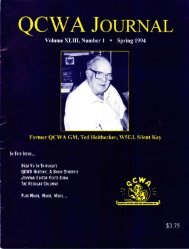
![11{J hI EfifSIt]E I]E - Quarter Century Wireless Association](https://img.yumpu.com/11816560/1/190x245/11j-hi-efifsite-ie-quarter-century-wireless-association.jpg?quality=85)
